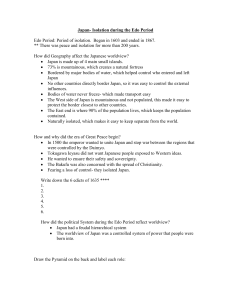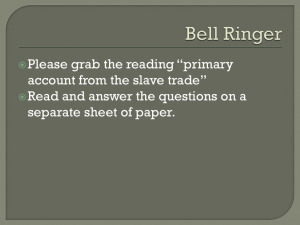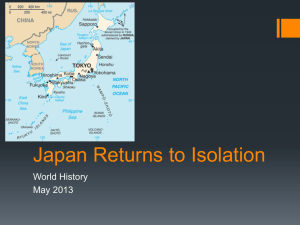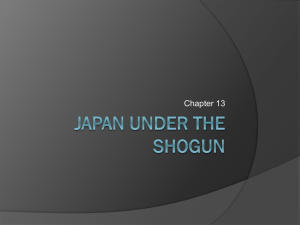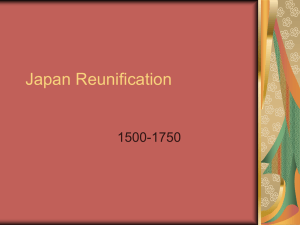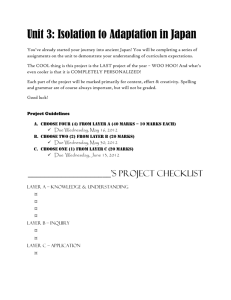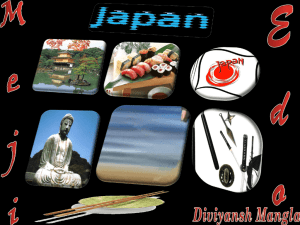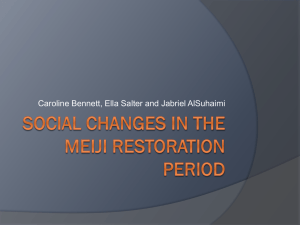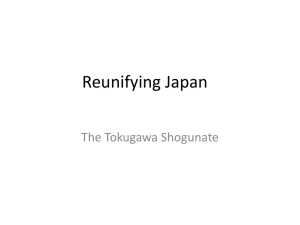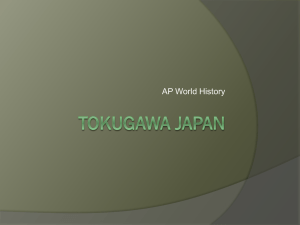Social Studies 8 Chapter 4
advertisement
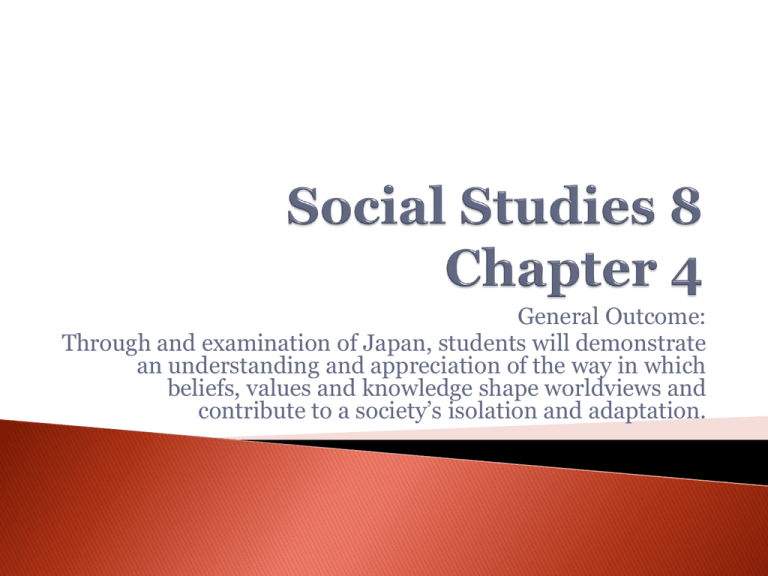
General Outcome: Through and examination of Japan, students will demonstrate an understanding and appreciation of the way in which beliefs, values and knowledge shape worldviews and contribute to a society’s isolation and adaptation. As a class we are going to analyze the effects of cultural isolation during the Edo period by exploring In what ways did Japan isolate itself from the rest of the world? How did isolation during the Edo period lead to changes in Japan? How did the changes resulting from isolation affect Japan economically, politically and socially during the Edo period? How did the physical geography of Japan affect its worldview? How did the shogun use the feudal system and the hierarchical social classes to maintain control of Japan? Take the next 10-15 minutes to complete the vocabulary for chapter 4 Page 124. Read the focus question. What do you think life would have been like in Japan in 1600, knowing what you know about life in Europe at the same time and modern Japan. Examine the map, why do you think Japan is at the centre? What does it say about the worldview of a society? How do the chapter titles on page 125 relate to the focus question? 1603-1867 Get into groups of 4-6 Respond to questions #1 and 2 on page 127 as a group The purpose of this activity is to get you to start thinking about the decisions that were on the mind of many Japanese leaders. Read pages 128-129 Grab a map handout of Japan Locate geographic features mentioned in the textbook on your map. Review page 10- How geography can effect the worldview of a society PREDICT some of the values and beliefs of the Japanese based on their geography. COMPARE the world maps or the classroom world map with the one on page 124. Japanese Art What other geographic features are in the print? Why do you think the artist made the waves so prominent? What other geographic features could be depicted in art? What geographic features would be in Canadian art? Read pages 132-133 (even the sidebar) Reflect and Respond #2 Read pages 134-136 What concerns did the shogun and the Bakufu have about foreign influences? What did they decide to do? – how does this compare to decisions you and your group made in the Worldview investigation activity? Pick one of the statements in the Closed Country Edict of 1635, and write it in your own words. i. Why do you think it was included in the edict? ii. How might it affect certain people? iii. How would authorities have planned to enforce this part of the edict? Read page 137 Do we have any codes of behaviour in Canada? Do any of them parallel Confucian values? Documentary Read pages 138-140 What do you think life would have been like for a daimyo? Reflect and respond # 1-2 #. 1 Authority and power can determine the organization and relationships among people. • Power: • Ability to act or to bring about an effect or change; it implies the ability to use force, not just influence. • Ability to exert influence beyond authority • Power can exist without authority. • Authority: • Implies the granting of power for a specific purpose with specified limits • Authority can exist with or without power; eg., teacher has authority over students, but does not have power over him. At times the words are used interchangeably. A person with power can delegate authority to others. A person in authority has power to make changes. #2. The shogun had the power to give the bakufu the authority to rule over the daimyo; i.e., to have power over how the daimyo would live. Bakufu maintained power over a daimyo by giving him a specific rank which determined: • location and size of residence in Edo • number of samurai he could bring to Edo • where he would be seated in palace • his credit rating among townsmen and merchants Bakafu also maintained power by • being able to relocate the daimyo or abolish his domain • making it impossible for the daimyo to form alliances among themselves • making it impossible for the daimyo to mass sufficient funds to pose a threat to the shogun Please read pages 141-145 ROLE PLAY: get into groups of 5-6 and do Question #1 page 145. When finished respond to question #2a page 145 Read 146-148 to find out what factors lead to the growth of cities during the Edo period. DISCUSS: how did the castle towns lead to the growth of cities? How did the annual pilgrimage to Edo change the map of Japan? Read about Japans three major cities (149-150) DISCUSS: what do these cities have in common? Why were they called the three metropolises? Those cities today: Discuss the concept/definition Could include cooking, clothing, mass media, entertainment, literature, and others. Create a mind map about popular culture in Canada today. After reading pages 151-154 create a web with popular culture at the center and add the elements of Japanese popular culture. DISCUSS: what factors brought people into contact with each other so that popular culture could develop in Japan? Read the profile page 155-156 Basho’s Trails Complete the Haiku handout Share your Haiku’s Read page 160 to compare the religious intolerance in Japan to similar situations in Europe at this time How were Christians treated in Japan? Why were they treated this way? How were Christians treated in other countries and why? Read page 161 to find out about how China and the Dutch influenced Japanese worldview, even in a period of isolation Is there any hint that Japan might change their policy of isolation? Answer question #1a & b page 161 Be sure to read page 162
